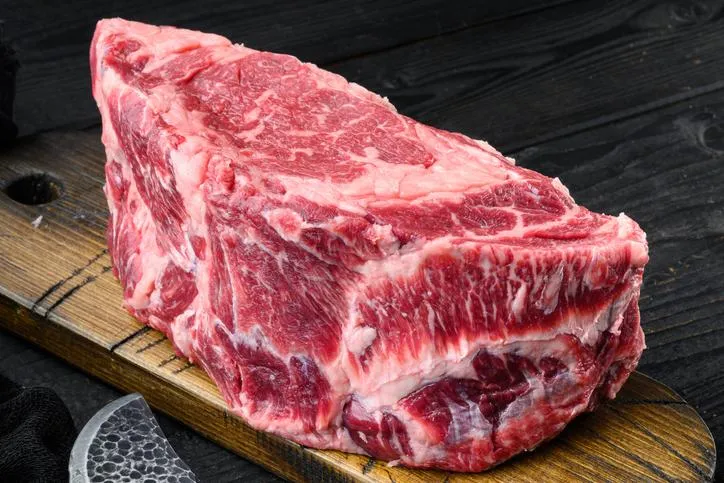
🥩 Featured Cut of the Week: Chuck Roast
The Shoulder Cut That Shouldn’t Be Slept On
If meat cuts had personalities, the chuck roast would be that gritty, dependable workhorse who shows up early, stays late, and never complains—even though it’s doing most of the heavy lifting. Often overshadowed by sexier steakhouse staples like ribeye or filet mignon, the chuck roast quietly holds down the fort as one of the most flavorful, versatile, and undervalued cuts of beef.
This week, we’re giving the chuck roast its flowers—and showing why it deserves a permanent place in your meat rotation.
📍 A Cut With Grit and Glory
The chuck roast comes from the shoulder section of the cow, an area that gets a serious workout. Because it supports so much of the animal’s weight and movement, the muscles in this region are loaded with dense fibers, connective tissue, and marbling.
That might sound like a challenge for your teeth, but it’s actually a huge plus—when cooked correctly, that connective tissue (especially collagen) breaks down into gelatin, creating a rich, silky texture and locking in deep, beefy flavor. It’s the kind of cut that rewards patience and technique.
💰 A Cut for the Budget—and the Bold
One of the chuck roast’s biggest selling points? Value. You’re getting serious meat for your money. Compared to brisket or short ribs, chuck is often half the price per pound, while delivering comparable flavor and tenderness when treated right.
That makes it a favorite among home cooks, pitmasters, and chefs alike. Whether you’re feeding a big family or meal-prepping for the week, chuck roast delivers maximum flavor at minimal cost.
🔀 A Chameleon in the Kitchen
There aren’t many cuts of beef as adaptable as the chuck roast. Its structure and fat content make it a natural for slow cooking, whether you're braising, roasting, or smoking. But it can also be broken down into other cuts, like:
Country-style ribs – technically not ribs at all, but from the chuck
Chuck eye – the "poor man's ribeye," cut close to the rib primal
You can cube it for stews, shred it for tacos, slice it for sandwiches, or serve it whole with gravy and sides. It’s the Swiss Army knife of beef cuts.
🔬 What Makes Chuck So Flavorful?
Let’s geek out on meat science for a second. The chuck roast is made up of multiple muscle groups, including the infraspinatus, teres major, and subscapularis, among others. That varied muscle structure, combined with intramuscular fat (marbling) and plenty of connective tissue, creates a rich, multidimensional bite you just don’t get from leaner cuts.
And while high-end cuts like tenderloin are prized for their texture, they’re often milder in flavor. Chuck roast, on the other hand, brings real depth—especially when cooked low and slow to coax out every bit of umami.
🔥 The Rise of Smoked Chuck
In recent years, the chuck roast has become a star in the world of backyard smoking. Why? Because it offers many of the same characteristics as brisket—big flavor, tough muscle, potential for juicy tenderness—but cooks in half the time.
Smoked chuck roast has earned nicknames like “Poor Man’s Brisket” or “Weeknight Brisket” because it delivers a barky, smoky finish without the 12+ hour commitment. For folks new to smoking or those who want that brisket vibe without breaking the bank, chuck is a perfect gateway cut.
🧠 Smart Cooking = Big Rewards
Despite its tough raw texture, the chuck roast is forgiving. You don’t need precision timing or advanced gear. You just need heat, moisture, and time.
Whether you’re braising it in the oven, slow-cooking it in broth, or letting it ride in a smoker, the magic happens when the meat hits that sweet spot of 200–205°F internal temperature, and the connective tissue melts away.
The key is knowing when it’s done—not just by temp, but by feel. A perfectly cooked chuck roast will probe like butter, fall apart with a fork, and release juices that are almost creamy in texture.
🛒 How to Buy It
You’ll find chuck roast at almost any grocery store or butcher. Look for:
Ask your butcher for a chuck roll if you want to break it down into custom portions, or a chuck eye roast for a more steak-like experience.
🧊 Leftovers That Don’t Feel Like Leftovers
Another reason to love chuck roast? It tastes even better the next day. The gelatin from the connective tissue firms up when chilled and then melts again when reheated, keeping the meat moist and flavorful.
You can repurpose it into:
Tacos or enchiladas
Sandwiches with horseradish cream or BBQ sauce
Hearty beef and barley soup
It’s the gift that keeps on giving.
🧠 The Chuck Roast Mindset
Cooking a chuck roast isn’t just a recipe—it’s a mindset. It’s about taking something tough and transforming it. It’s about patience, technique, and knowing that good things take time. It’s a cut that represents everything we love about meat: boldness, flavor, and the satisfaction of earning every bite.
So the next time you’re scanning the meat case for something special, skip the fancy steaks and pick up a chuck roast. Give it the time it deserves, and it’ll reward you tenfold.
Because in the world of beef, the underdog often ends up the champion.
Stay tuned for next week’s Featured Cut and keep turning those undervalued cuts into unforgettable meals. Until then—keep your knives sharp and your fires hotter. 🔥🥩
